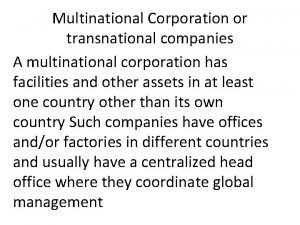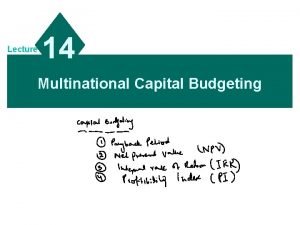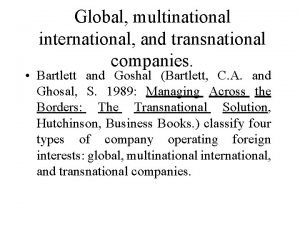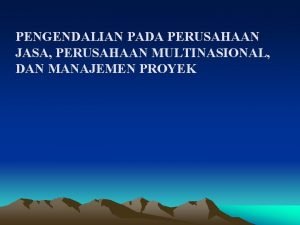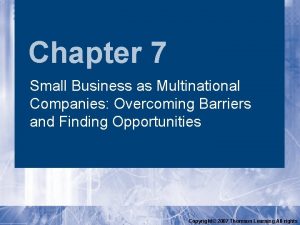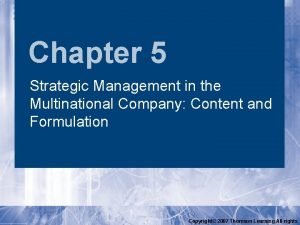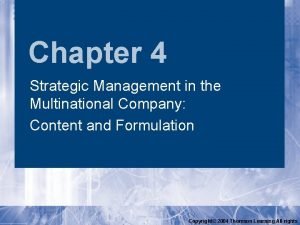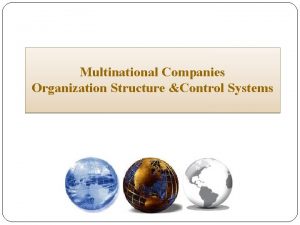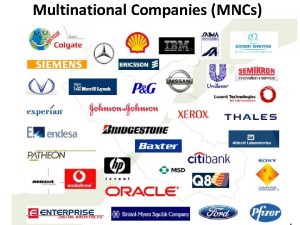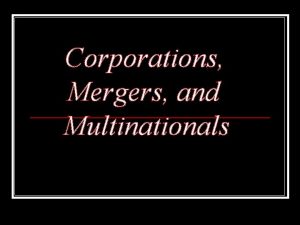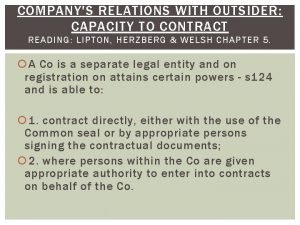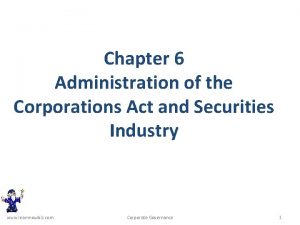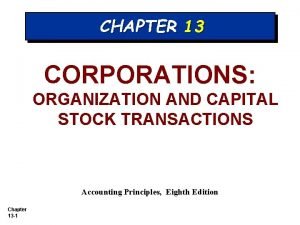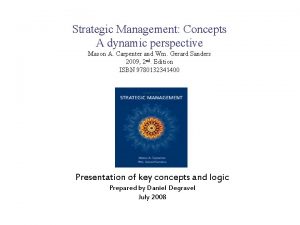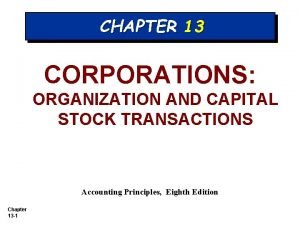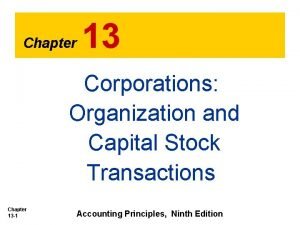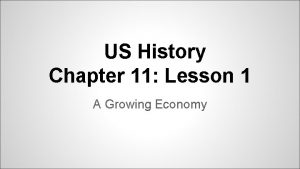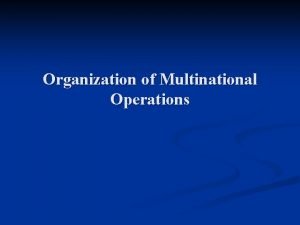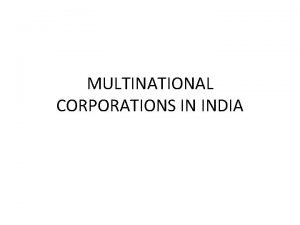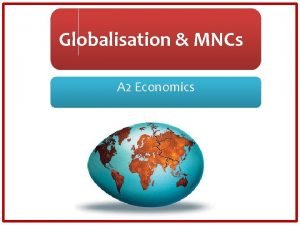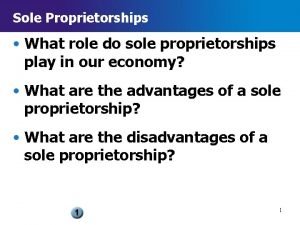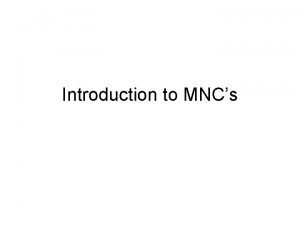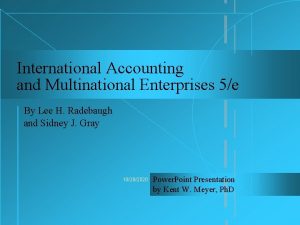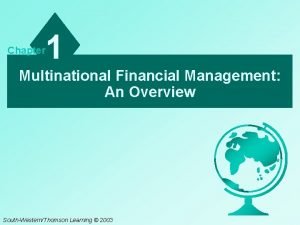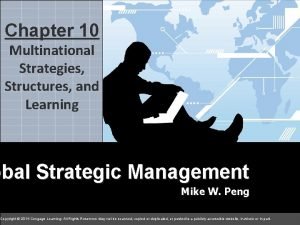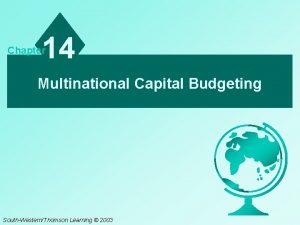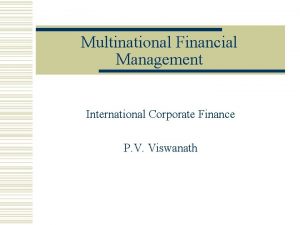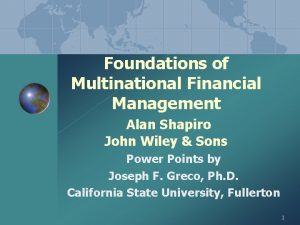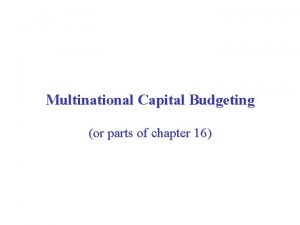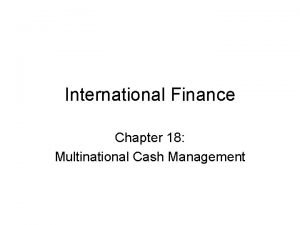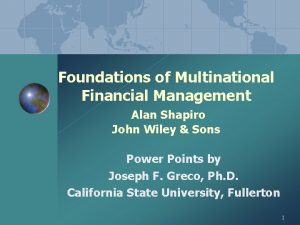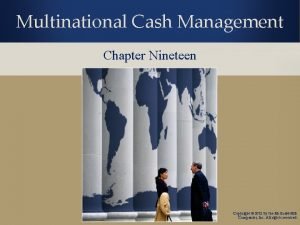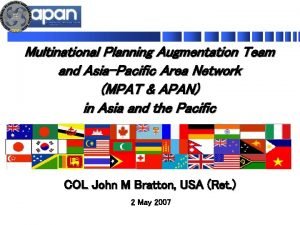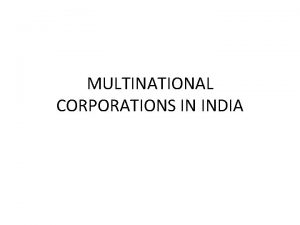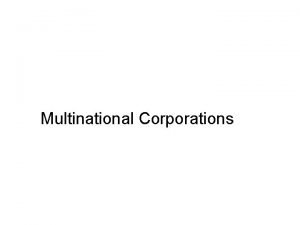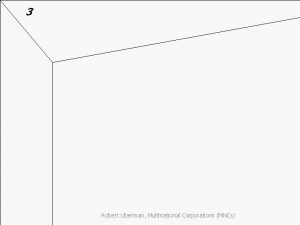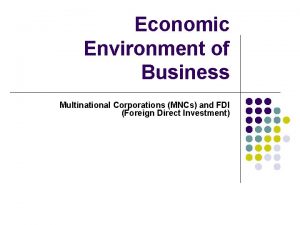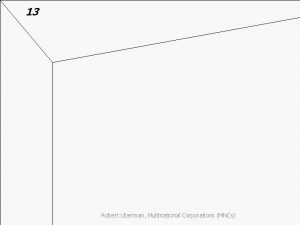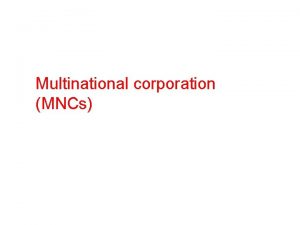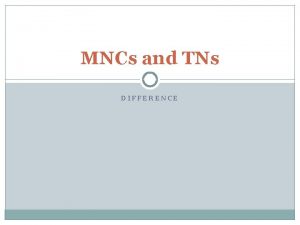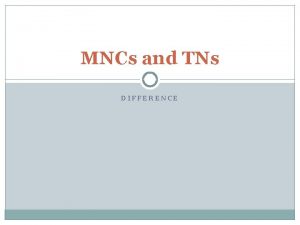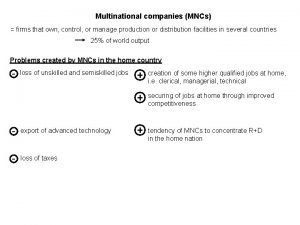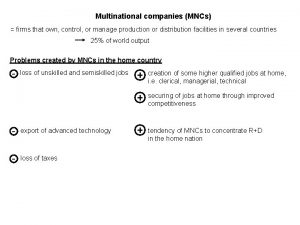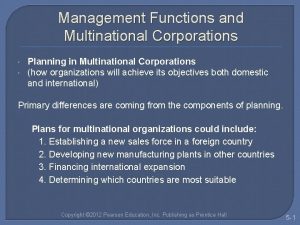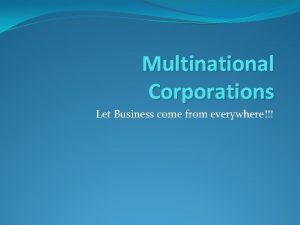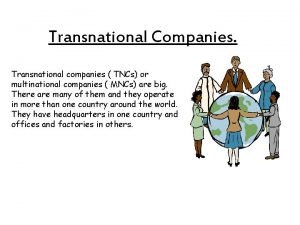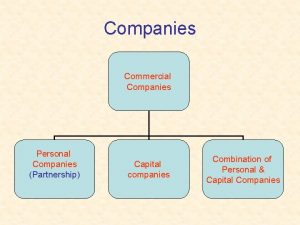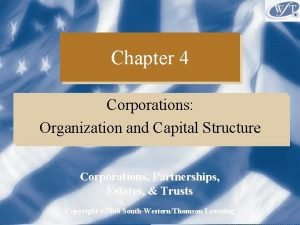Multinational Companies MNCs Multinational Companies MNCs Multinational Corporations














































- Slides: 46

Multinational Companies (MNCs)

Multinational Companies (MNCs) • • Multinational Corporations: Definition; Organizational Structures Dominance of MNC’s Recent Trends Code of Conduct Multinationals in India

Multinational Companies (MNCs) • A multinational company is one which is incorporated in one country (called the home country); but whose operations extend beyond the home country and which carries on business in other countries (called the host countries) in addition to the home country. • It must be emphasized that the headquarters of a multinational company are located in the home country. • Neil H. Jacoby defines a multinational company as follows: “A multinational corporation owns and manages business in two or more countries. ”

Five Criteria of MNC 1. It operates in many countries at different levels of economic development 2. Its local subsidiaries are managed by nationals 3. It maintains complete industrial organizations, including R and D and manufacturing facilities, in several countries 4. It has a multinational central management 5. It has multinational stock ownership

Some popular examples of multinationals are given below:

Features of Multinational Corporations (MNCs): i) Huge Assets and Turnover: Because of operations on a global basis, MNCs have huge physical and financial assets. This also results in huge turnover (sales) of MNCs. In fact, in terms of assets and turnover, many MNCs are bigger than national economies of several countries. (ii) International Operations Through a Network of Branches: MNCs have production and marketing operations in several countries; operating through a network of branches, subsidiaries and affiliates in host countries. (iii) Unity of Control: MNCs are characterized by unity of control. MNCs control business activities of their branches in foreign countries through head office located in the home country. Managements of branches operate within the policy framework of the parent corporation.

(iv) Mighty Economic Power: MNCs are powerful economic entities. They keep on adding to their economic power through constant mergers and acquisitions of companies, in host countries. (v) Advanced and Sophisticated Technology: Generally, a MNC has at its command advanced and sophisticated technology. It employs capital intensive technology in manufacturing and marketing. (vi) Professional Management: A MNC employs professionally trained managers to handle huge funds, advanced technology and international business operations.

(vii)Aggressive Advertising and Marketing: MNCs spend huge sums of money on advertising and marketing to secure international business. This is, perhaps, the biggest strategy of success of MNCs. Because of this strategy, they are able to sell whatever products/services, they produce/generate. (viii) Better Quality of Products: A MNC has to compete on the world level. It, therefore, has to pay special attention to the quality of its products.

Advantages and Limitations of MNCs: Viewpoint of Host Country (i) Employment Generation: MNCs create large scale employment opportunities in host countries. This is a big advantage of MNCs for countries; where there is a lot of unemployment. (ii) Automatic Inflow of Foreign Capital: MNCs bring in much needed capital for the rapid development of developing countries. In fact, with the entry of MNCs, inflow of foreign capital is automatic. As a result of the entry of MNCs, India e. g. has attracted foreign investment with several million dollars. (iii) Proper Use of Idle Resources: Because of their advanced technical knowledge, MNCs are in a position to properly utilize idle physical and human resources of the host country. This results in an increase in the National Income of the host country.

(iv) Improvement in Balance of Payment Position: MNCs help the host countries to increase their exports. As such, they help the host country to improve upon its Balance of Payment position. (vi) Technical Development: MNCs carry the advantages of technical development 10 host countries. In fact, MNCs are a vehicle for transference of technical development from one country to another. Because of MNCs poor host countries also begin to develop technically. (vii) Managerial Development: MNCs employ latest management techniques. People employed by MNCs do a lot of research in management. In a way, they help to professionalize management along latest lines of management theory and practice. This leads to managerial development in host countries.

(viii) End of Local Monopolies: The entry of MNCs leads to competition in the host countries. Local monopolies of host countries either start improving their products or reduce their prices. Thus MNCs put an end to exploitative practices of local monopolists. As a matter of fact, MNCs compel domestic companies to improve their efficiency and quality. In India, many Indian companies acquired ISO-9000 quality certificates, due to fear of competition posed by MNCs. (ix) Improvement in Standard of Living: By providing super quality products and services, MNCs help to improve the standard of living of people of host countries. (x) Promotion of international brotherhood and culture: MNCs integrate economies of various nations with the world economy. Through their international dealings, MNCs promote international brotherhood and culture; and pave way for world peace and prosperity.

Limitations of MNCs from the Viewpoint of Host Country: (i) Danger for Domestic Industries: MNCs, because of their vast economic power, pose a danger to domestic industries; which are still in the process of development. Domestic industries cannot face challenges posed by MNCs. Many domestic industries have to wind up, as a result of threat from MNCs. Thus MNCs give a setback to the economic growth of host countries. (ii) Repatriation of Profits: (Repatriation of profits means sending profits to their country). MNCs earn huge profits. Repatriation of profits by MNCs adversely affects the foreign exchange reserves of the host country; which means that a large amount of foreign exchange goes out of the host country. (iii) No Benefit to Poor People: MNCs produce only those things, which are used by the rich. Therefore, poor people of host countries do not get, generally, any benefit, out of MNCs.

(iv) Danger to Independence: Initially MNCs help the Government of the host country, in a number of ways; and then gradually start interfering in the political affairs of the host country. There is, then, an implicit danger to the independence of the host country, in the long-run. (v) Disregard of the National Interests of the Host Country: MNCs invest in most profitable sectors; and disregard the national goals and priorities of the host country. They do not care for the development of backward regions; and never care to solve chronic problems of the host country like unemployment and poverty. (vi) Misuse of Mighty Status: MNCs are powerful economic entities. They can afford to bear losses for a long while, in the hope of earning huge profits-once they have ended local competition and achieved monopoly. This may be the dirties strategy of MNCs to wipe off local competitors from the host country.

(vii) Careless Exploitation of Natural Resources: MNCs tend to use the natural resources of the host country carelessly. They cause rapid depletion of some of the non-renewable natural resources of the host country. In this way, MNCs cause a permanent damage to the economic development of the host country. (viii) Selfish Promotion of Alien Culture: MNCs tend to promote alien culture in host country to sell their products. They make people forget about their own cultural heritage. In India, e. g. MNCs have created a taste for synthetic food, soft drinks etc. This promotion of foreign culture by MNCs is injurious to the health of people also. (ix) Exploitation of People, in a Systematic Manner: MNCs join hands with big business houses of host country and emerge as powerful monopolies. This leads to concentration of economic power only in a few hands. Gradually these monopolies make it their birth right to exploit poor people and enrich themselves at the cost of the poor working class.

Advantages of the MNCs from the viewpoint of the home country i) MNCs usually get raw-materials and labor supplies from host countries at lower prices; specially when host countries are backward or developing economies. (ii) MNCs can widen their market for goods by selling in host countries; and increase their profits. They usually have good earnings by way of dividends earned from operations in host countries. (iii) Through operating in many countries and providing quality services, MNCs add to their international goodwill on which they can capitalize, in the long-run.

Limitations of MNCs from the viewpoint of home country (i) There may be loss of employment in the home country, due to spreading manufacturing and marketing operations in other countries. (ii) MNCs face severe problems of managing cultural diversity. This might distract managements’ attention from main business issues, causing loss to the home country. (iii) MNCs may face severe competition from bigger MNCs in international markets. Their attention and finances might be more devoted to wasteful counter and competitive advertising; resulting in higher marketing costs and lesser profits for the home country.

Organizational Structures Subsidiary Model • Owning foreign subsidiaries is one of the most basic structural models of a multinational company. • The subsidiaries are self-contained units with their own operations, finance and human resource functions. • Thus the foreign subsidiaries are autonomous allowing them to respond to local competitive conditions and develop locally responsive strategies. • The major disadvantage of this model however is the decentralization of strategic decisions that makes it difficult for a unified approach to counter global competitive attacks.

Product Division • Organizational structure of the multinational company in this case is developed on the basis of its product portfolio. • Each product has its own division that is responsible for the production, marketing, finance and the overall strategy of that particular product globally. • The product organizational structure allows the multinational company to weed out product divisions that are not successful. • The major disadvantage of this divisional structure is the lack of integral networks that may increase duplication of efforts across countries.

Area Division • Organization using this model is again divisional in nature, and the divisions are based on the geographical area. Each geographical region is responsible for all the products sold within its region. • Therefore all the functional units for that particular region namely finance, operations and human resources are under the geographical region responsibility. • This structure allows the company to evaluate the geographical markets that are most profitable. However communication problems, internal conflicts and duplication of costs remain an issue.

Functional Structure • Functions such as finance, operations, marketing and human resources determine the structure of the multinational company in this model. • For example, all the production personnel globally for a company work under the parameters set by the production department. • The advantage of using this structure is that there is greater specialization within departments and more standardized processes across the global network. • The disadvantages include the lack of inter department communication and networking that contributes to more rigidity within the organization.

Matrix Structure • Matrix organizational structure is an overlap between the functional and divisional structures. The structure is characterized by dual reporting relationships in which employees report both to the functional manager and the divisional manager. • Work projects involve cross-functional teams from multiple functions such as finance, operations and marketing. • The members of teams would report both to the project manager as well as their immediate supervisors in finance, operations and marketing. • The advantage of this structure is that there is more cross -functional communication that facilitates innovation. • The decisions are also more localized. However there can more confusion and power plays because of the dual line of command.

Transnational network • Evolution of the matrix structure has led to the transnational network. • The emphasis is more on horizontal communication. • Information is now shared centrally using new technology such as “enterprise resource planning (ERP)” systems. • This structure is focused on establishing “knowledge pools” and information networks that allow global integration as well local responsiveness.

International division structure • Suited to larger corporations. • Also effective for smaller companies that have an established home market and a rapidly growing international business. • It leaves the company free to maintain the focus on its home market in its main organization while leaving the international division free to adapt to the foreign markets in which it is active.


Advantage • Easy control and communication • Quick adaptation to changing environment Disadvantage • Conflict between domestic and international division • Inability to cope with the demand of expansion and growth • Low priority may be on the international market.

Global functional structure • Uses corporate functions as the basis for its organizational structure. • Production, human resources, design and customer service are typical functional units. • If a functionally organized company has a centralized structure, all operations are based in the home country and individual employees have responsibilities for different national markets. • This type of organization is efficient and effective for companies that are too small to have overseas subsidiaries. • Larger companies can have this type of organization, but in a decentralized form, where foreign employees carry out some of the work in their own countries. • In this case, companies have to pay special attention to coordinating activities.


ADVANTAGES DISADVANTAGES • Promotes functional • Slow adaptation to expertise. environmental changes. • Easy control and supervision. • Poor communications across the functional • Focused attentions on key departments. function • Sub optimization due to focused attention on functions.

Regional area structure • In addition to the home office or headquarters, semi-independent operations are established in the countries where the company is active. • For larger corporations, these can take the form of subsidiaries, while smaller companies can have something as simple as an agent or a small office. • This structure affords flexibility; the head office can transfer responsibilities abroad if required by local conditions

Parent Company NEPAL Subsidiaries Singapore Subsidiaries China Subsidiaries Europe Subsidiaries South East Asia

Advantage Disadvantage • Flexibility and independence • Risk diversification and focused control • Quick response to conditions • Polycentric management is possible • Ease in divestment • Duplication of resources and efforts • Lack of coordination among regions • Risk of divestment to subsidiaries • Control from the center

Matrix structure • A matrix organizational structure combines the efficiency of the functionally organized company with the flexibility of extensive local operations. • Foreign workers report to local managers for questions about their work, while they report to the head office for all other functions.


Advantage • Quick environmental adaptation • Promote organizational flexibility Disadvantage • Conflicts arises between divisional and functional managers • Slow decision making

Dominance of MNC’s • The economic dominance of the multinationals is manifested by the fact that the MNCs control between a quarter and a third of all world production and the total sales of their foreign affiliates is about the same as the gross national product of all developing countries excluding oilexporting developing countries. • The major part of the business of the MNCs is in the developed economies. The share of the developed countries in the tot. al overseas investment was, in fact, increasing. • According to Professors Dunning and Stop for, developing countries' share of foreign direct investment slipped to 27 per cent by 1980 from 31 per cent in 1971. 16 It dropped further to 17 per cent during 1986 -90. 17 However, the 1990 s witnessed an increase in the share of the developing countries in the multinational investments. • The economic reform ushered in the developing countries, particularly the liberalisation of foreign investment and privatization, might have given a boost to the FDI in these countries. In the case of the LDCs, the investment and employment created by the MNCs have been chiefly concentrated in about a dozen of the nations; China, Brazil, Mexico, Hong Kong, the Philippines, Singapore, India, Taiwan, Indonesia and South Korea accounting for a major share

• As the Brandt Commission observes, foreign investment has moved to a limited number of developing countries, mainly those which could offer political stability and The economic clout of the MNCs is indicated by the fact that the GDP of most of the countries is smaller than the value of the annual sales turnover of the multinational giants. • In 1997, the value of the sales of the US multinational, General Motors, the biggest multinational in terms of sales turnover, was $ 178. 2 billion. Of the total 101 developing countries with a population of more than one million each, listed by the World Development Report, only nine countries ( India China, Mexico, Argentina, Indonesia, Turkey, Brazil, Russia and S. Korea) had a GDP which was more than this figure. • There were also several developed countries whose value of GDP was less than this. It may be noted that in 1997 India's GDP was only $359. 8 billion

• Due to the differences in the definition adopted, the estimates of the numbers of MNCs also vary. According to the United Nations' World Investment Report J 998, there were more than 53, 000 TNCs, which had more than 4, 50, 000 affiliates, • The United States and Europe are the homes for most of the MNCs. , Their shares have, however, been declining because of the growth of MNCs in other regions, Japanese MNCs have made rapid strides in the 1970 s and 1980 s. In 1991, majority of the 10 largest multinationals (in terms of sales) were Japanese. • Multinationals from developing countries such as S. Korea and Taiwan have also been making their presence increasingly felt.

Recent Trends • Increasing emphasis on market forces and a growing role for the private sector in nearly all developing countries. • Rapidly changing technologies that are transforming the nature of organization and location of international production. • The globalization of firms and industries. • The rise of services to constitute the largest single sector in the world economy. • Regional economic integration, which involves both the worlds largest economies and selected developing countries.

Code of Conduct

• A Code of Conduct is a written collection of the rules, principles, values, and employee expectations, behavior, and relationships that an organization considers significant and believes are fundamental to their successful operation. • A Code of Conduct enumerates those standards and values that make an organization remarkable and that enable it to stand out from similar organizations. The Code of Conduct is named by an organization to reflect the culture that is present in the organization and to make a statement. • The Purpose of a Code of Conduct • While Code of Conduct is a popular title, other companies call it their Code of Business Ethics, Code of Ethical Business Conduct and Code of Ethics and Standards. The last is popular in professional associations. No matter what an organization calls it, the Code of Conduct serves as a framework for ethical decision making within an organization. The Code of Conduct is a communication tool that informs internal and external stakeholders about what is valued by a particular organization, its employees, and management. • The Code of Conduct is the heart and soul of a company. Think of a Code of Conduct as an in-depth view of what an organization believes and how the employees of an organization see themselves and their relationship with each other and the rest of the world. The Code of Conduct paints a picture of how employees, customers, partners, and suppliers can expect to be treated as a result.

This offers one model. According to the Brandit Commission, the principal elements of an international regime for investment should include: • 1. A framework to allow developing countries as well as transnational corporations to benefit from direct investment on contractually agreed upon. Home countries should not restrict investment or the transfer of technology abroad, and should desist from other restrictive practices such as export controls or market allocation arrangements. Host countries in turn should not restrict current transfers such as profits, royalties and dividends, or the repatriation of capital, so long as they are on which were agreed when the investment was originally approved or subsequently negotiated.

2. Legislation promoted and coordinated in home and host countries, to regulate the activities of transnational corporations in such matters as ethical behavior, disclosure of information, restrictive business practices, cartels, anticompetitive practices and labor standards. International codes and guidelines are a useful step in that direction. 3. Cooperation by governments in their tax policies to monitor transfer pricing and to eliminate the resort to tax havens.

4. Fiscal and other incentives and policies towards foreign investment to be canonized among host developing countries, particularly at regional and sub regional levels, to avoid the under lining of the tax base and competitive positions of host countries 5. An international procedure for discussions and consultations on measures affecting direct investment and the activities of transnational corporations.

Multinationals in India • India Inc. is flying high. Not only over the Indian sky. Many Indian firms have slowly and surely embarked on the global path and lead to the emergence of the Indian multinational companies. • With each passing day, Indian businesses are acquiring companies abroad, becoming world-popular suppliers and are recruiting staff cutting across nationalities. While an Asian Paints is painting the world red, Tata is rolling out Indicas from Birmingham and Sundram Fasteners nails home the fact that the Indian company is an entity to be reckoned with. • Some instances: • Tata Motors sells its passenger-car Indica in the UK through a marketing alliance with Rover and has acquired a Daewoo Commercial Vehicles unit giving it access to markets in Korea and China. • Ranbaxy is the ninth largest generics company in the world. An impressive 76 percent of its revenues come from overseas. • Dr Reddy's Laboratories became the first Asia Pacific pharmaceutical company outside Japan to list on the New York Stock Exchange in 2001.

• Asian Paints is among the 10 largest decorative paints makers in the world and has manufacturing facilities across 24 countries. • Small auto components company Bharat Forge is now the world's second largest forgings maker. It became the world's second largest forgings manufacturer after acquiring Carl Dan Peddinghaus a German forgings company last year. Its workforce includes Japanese, German, American and Chinese people. It has 31 customers across the world and only 31 percent of its turnover comes from India. • Essel Propack is the world's largest manufacturers of lamitubes - tubes used to package toothpaste. It has 17 plants spread across 11 countries and a turnover of Rs 609. 2 crore for the year ended December 2003. The company commands a staggering 30 percent of the 12. 8 billion-units global tubes market. • About 80 percent of revenues for Tata Consultancy Services comes from outside India. This month, it raised Rs 54. 2 billion ($1. 17 billion) in Asia's second-biggest tech IPO this year and India's largest IPO ever. • Infosys has 25, 634 employees including 600 from 33 nationalities other than Indian. It has 30 marketing offices across the world and 26 global software development centres in the US, Canada, Australia, the UK and Japan. • Sundram Fasteners is not merely a nuts and bolts company. It believes in thinking out of the box. Probably that is why it decided to acquire a plant in China. The plant in Jiaxin city in the Haiyan economic zone has ensured one fact: that its customers who were earlier buying Sundram products in Europe and the US, did not have to go far from home to access the product.

• http: //www. economicsdiscussion. net/multina tional-corporations/multinationalcorporations-mncs-meaning-origin-andgrowth/20921 • http: //www. yourarticlelibrary. com/india 2/multinational-corporations/multinationalcorporations-mncs-meaning-features-andadvantages-business/69418 • https: //www. mckinsey. com/businessfunctions/strategy-and-corporate-finance/ourinsights/how-multinationals-can-win-in-india • https: //www. livemint. com/Companies/t 6 w. KA x 4 HAhpl 4 MKw. CY 1 l. JL/The-steady-rise-of. MNCs. html
 Multinational vs transnational corporations
Multinational vs transnational corporations Multinational capital budgeting
Multinational capital budgeting Difference between global company and multinational company
Difference between global company and multinational company Multinational corporation definition
Multinational corporation definition Multinational financial services company
Multinational financial services company Small multinational companies
Small multinational companies Strategic planning in multinational companies
Strategic planning in multinational companies Strategic management in multinational companies
Strategic management in multinational companies Domestic structure plus export department
Domestic structure plus export department Disadvantages of mncs
Disadvantages of mncs Corporations mergers and multinationals
Corporations mergers and multinationals Freeman & lockyer v buckhurst park properties
Freeman & lockyer v buckhurst park properties The characteristics of corporation
The characteristics of corporation Disadvantages of corporations
Disadvantages of corporations Learnnowbiz
Learnnowbiz Accounting for corporations chapter 13
Accounting for corporations chapter 13 Fighting means corporations
Fighting means corporations Issued common stock for cash journal entry
Issued common stock for cash journal entry Corporate capital
Corporate capital Types of corporations
Types of corporations Corporations developed rapidly in the 1830s
Corporations developed rapidly in the 1830s Chapter 7 corporations act
Chapter 7 corporations act Organizational structure of mncs
Organizational structure of mncs Many mncs use forward contracts.
Many mncs use forward contracts. Multi corporation meaning
Multi corporation meaning Advantages of sole proprietorship
Advantages of sole proprietorship Globalisation objective
Globalisation objective Disadvantages of mncs
Disadvantages of mncs Introduction to mnc
Introduction to mnc Multinational vs international
Multinational vs international International accounting and multinational enterprises
International accounting and multinational enterprises Expanded opportunity set
Expanded opportunity set Multinational financial management an overview
Multinational financial management an overview Four strategic choices for mnes
Four strategic choices for mnes Multinational capital budgeting
Multinational capital budgeting Multinational capital structure
Multinational capital structure Multinational corporate finance
Multinational corporate finance Foundations of multinational financial management
Foundations of multinational financial management Finnish multinational communications corporation
Finnish multinational communications corporation Multinational capital budgeting
Multinational capital budgeting Whats ethnicity mean
Whats ethnicity mean Multinational netting
Multinational netting Multinational financial management shapiro
Multinational financial management shapiro Multinational cash management
Multinational cash management Cairo conference definition ap human geography
Cairo conference definition ap human geography Multinational capital budgeting
Multinational capital budgeting Mnf sop
Mnf sop
